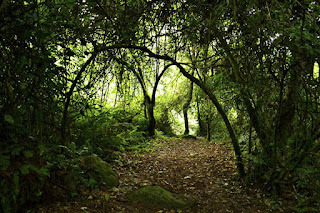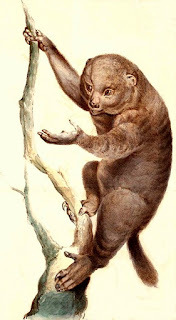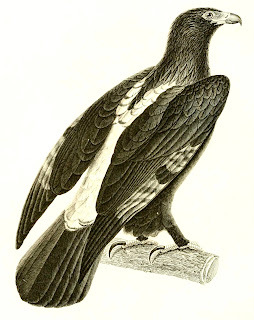SOME CRYPTOZOOLOGICAL RIDDLES FROM RUWENZORI
 Deepwithin the green secluded forest kingdom of Ruwenzori (© Diego Tirira/Wikipedia –
CC BY-SA 2.0 licence
)
Deepwithin the green secluded forest kingdom of Ruwenzori (© Diego Tirira/Wikipedia –
CC BY-SA 2.0 licence
)Ruwenzori (aka Rwenzori and Rwenjura)constitutes an East African mountain range at the border of the DemocraticRepublic of the Congo (formerly Zaire) and Uganda. Below their peaks' snowycaps and alpine meadows, these mountains are covered in lush tropicalrainforests and are rightly deemed to be a biodiversity hotspot, with manyregions still only sparsely explored scientifically. Not surprisingly,therefore, some interesting potential cryptids have been reported fromRuwenzori, including the three examples presented here.
GOING POTTYABOUT A GIANT POTTO
Some of cryptozoology's least-known mystery beastshave often long been hiding in plain sight, at least in the sense that theyhave been documented in books or articles originally published many years agobut which have never attracted cryptozoological attention. Consequently,whenever possible I try to rectify this sad situation by publicising thesecryptic cryptids once I've learnt about them.
So here is yet another example, kindly brought to myattention on Facebook by longstanding FB friend Richard Hing on 16 August 2023.
In his FB post, Richard wondered if anyone had everheard of a strange creature reportedly existing in Ruwenzori and brieflyreferred to by BBC wildlife film-maker/author Michael Bright in a BBC Wildlife Magazine article fromNovember 1987 concerning the fauna of these infamously impenetrable, inaccessiblemountains.
Michael had been writing about how fascinated by theRuwenzoris and their natural history was Pelham Aldrich-Blake, producer of therenowned TV series The Natural Worldand a longstanding lover of mountain-climbing, and while listing the variouscreatures existing here Michael included the following short but verytantalising paragraph:
Pelham also mentions the occasionalsolitary leopard and a creature that most people consider more mythical thanfact – the 1.5m [5-ft]-long giant Ruwenzori potto, which shares the scientifictwilight with Nessie and the yeti. It is described in the [local native]stories as simply a huge version of the well-known big-eyed primate and issupposed to glower at intruders from the branches of 10m-tall giant heathers.
 Vintage19th-Century illustration of the common or West African potto Perodicticus potto (public domain)
Vintage19th-Century illustration of the common or West African potto Perodicticus potto (public domain)
Pottos are related to and somewhat resemble the morefamiliar lorises of Asia, especially the slow lorises. For many years, only asingle geographically-widespread potto species, Perodicticus potto, was recognised, inhabiting West Africa, CentralAfrica, and East Africa, but in more recent times this species has been dividedtaxonomically into three separate ones, based on genetic analyses published in2015 indicating that they split from one another in evolutionary terms as longago as the Miocene Epoch (23-5.3 million years ago).
These are now, respectively, the common or WestAfrican potto P. potto, the CentralAfrican potto P. edwarsi, and theEast African potto P. ibeanus. (Thereis also the mysterious false potto Pseudopottomartini, represented only by skeletal remains from two specimens ofuncertain provenance and unknown external appearance, but which may merely beaberrant specimens of P. potto.)
Nevertheless, they are all still united by one verynoticeable shared feature – none of them exceeds around 50 cm [20 in] (includingits short tail) in total length, i.e. only a third the alleged length of theaptly-dubbed giant Ruwenzori potto. Consequently, assuming that the latterreally does exist, and really is 1.5 m (i.e. 150 cm) [5 ft] long, it seemsreasonable to speculate that this exceptionally large variation on the pottotheme does indeed represent a taxonomically discrete form still awaiting scientificrecognition and naming. Incidentally, if anyone has additional informationconcerning it, I would love to receive details!
Nor is this giant potto the only obscurecryptozoological curiosity on record from the Ruwenzoris.
THEMOON BIRDS OF RUWENZORI
Two totally separate reports of very large butstill-unidentified black birds have also been chronicled from these loftypeaks, popularly and poetically dubbed the Mountains of the Moon because theywere traditionally believed to be the real-life identity of the mysterious legendarymountains given this romantic name by ancient Greek and Roman geographers whobelieved that they comprised the long-hidden source of the River Nile.
The first 'moon bird' report, documented by JohnPreston in his Ruwenzoris travelogue TouchingThe Moon, is that of that of the local guide accompanying explorer StephenBagge during his Ruwenzori ascent in 1898.
Bagge reached an altitude of 9,000 ft, but his guideclimbed a little higher, alone, reaching Lake Bujuku, south of Mount Speke.According to this guide, he saw on its shores a number of all-black birds aslarge as sheep, which uttered an alarm call resembling the bellow of a bullwhen he tried to approach them, which scared him away. In 1906, conversely, avery extensive Ruwenzoris expedition led by Italian explorer the Duke ofAbruzzi did not report encountering any such birds there.
However, in his 1957 book Animal Africa, Canadian mountaineer Earl Denman recalled that whileclimbing the Ruwenzoris a few years earlier, he had watched a couple of verylarge unidentifiable black birds diving swiftly and almost vertically throughthe high mountain air. Were these of the same mystery species as those thatBagge's guide had seen, or something different again?
 Verreaux's eagle, painted by René Primevère Lesson, 1830 (publicdomain)
Verreaux's eagle, painted by René Primevère Lesson, 1830 (publicdomain)
Cryptozoological author George Eberhart hasspeculated that Denman's birds may have been a pair of Verreaux's eagles Aquila verreauxii – a striking species thatis indeed native to the highlands of East Africa, has predominantly blackplumage, a very impressive wingspan of up to 8 ft, and an extremely dramaticaerial courtship display that features spectacular vertical dives.
Consequently, I think this a plausible identity forDenman's birds, but Bagge's remain far more mystifying.
After all, it seems unlikely that a number of eagleswould all congregate together around the shores of a lake, and utter abull-like sound when approached. To me, such behaviour is much more indicativeof birds such as cranes, herons, storks, or even bustards, but I'm not aware ofany known species that corresponds both morphologically and zoogeographicallywith Bagge's birds.
And so, over a century later, these remain asenigmatic now as they were back in 1896. Once again, any additional info wouldbe very welcome!
 Koribustard Ardeotis kori, Africa'slargest flying bird (only the flightless ostrich is larger), standing 5 ft talland weighing 24-42 lb in the adult male (females are only half this size), butnot native to Ruwenzori (© Haplochromis/Wikipedia –
CC BY-SA 3.0 licence
)
Koribustard Ardeotis kori, Africa'slargest flying bird (only the flightless ostrich is larger), standing 5 ft talland weighing 24-42 lb in the adult male (females are only half this size), butnot native to Ruwenzori (© Haplochromis/Wikipedia –
CC BY-SA 3.0 licence
)
Karl Shuker's Blog
- Karl Shuker's profile
- 45 followers



